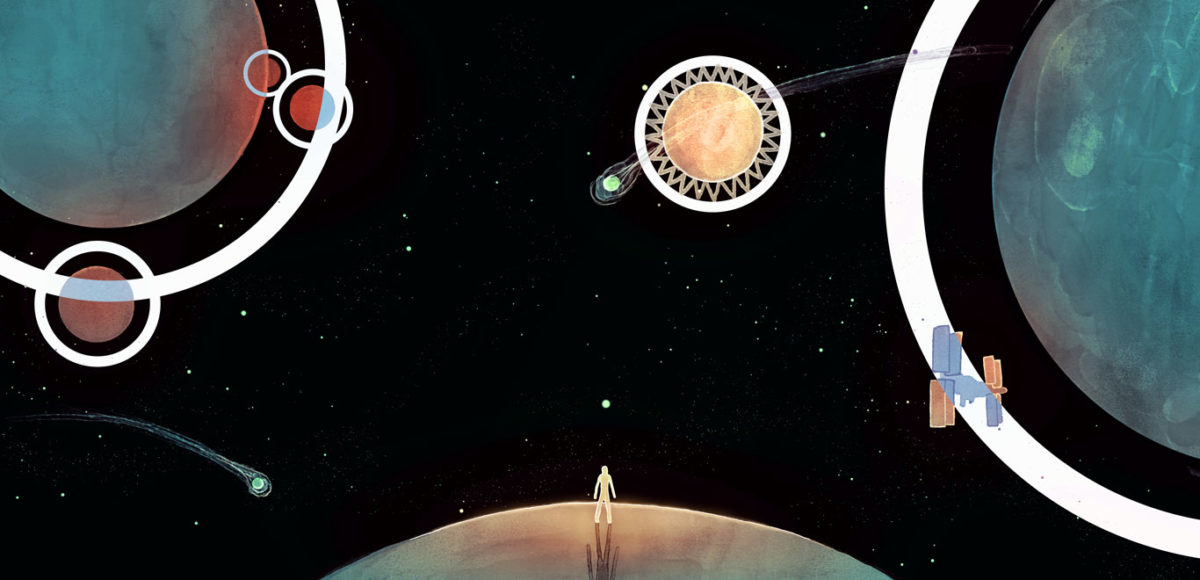by Martin Rees
If the number one question astronomers are asked is, Are we alone?, the number two question is surely, Do you believe in God? My conciliatory answer is that I do not, but that I share a sense of wonder and mystery with many who do.
The interface between science and religion still engenders controversy, even though there has been no essential change since the seventeenth century. Newton’s discoveries triggered a range of religious (and antireligious) responses. So, even more, did Charles Darwin in the nineteenth century. Today’s scientists evince a variety of religious attitudes; there are traditional believers as well as hard-line atheists among them. My personal view–a boring one for those who wish to promote constructive dialogue (or even just unconstructive debate) between science and religion–is that, if we learn anything from the pursuit of science, it is that even something as basic as an atom is quite hard to understand. This should induce scepticism about any dogma, or any claim to have achieved more than a very incomplete and metaphorical insight into any profound aspect of existence. As Darwin said, in a letter to the American biologist Asa Gray: ‘I feel most deeply that the whole subject is too profound for the human intellect. A dog might as well speculate on the mind of Newton. Let each man hope and believe as he can’.
Anything can be ‘explained’ by invoking supernatural intervention. So, if success is measured by having an explanation, however ‘flip’, then the ‘intelligent designers’ will always win.
Creationists believe that God created the Earth more or less as it is–leaving no scope for the emergence of new species or enhanced complexity and paying little regard to the wider cosmos. It is impossible to refute, by pure logic, even someone who claims that the universe was created an hour ago, along with all our memories and all vestiges of earlier history. ‘Creationist’ concepts still hold sway among many US evangelicals and in parts of the Muslim world. In Kentucky there is a ‘creation museum’ with what its promoters describe as a ‘full-size’ Noah’s Ark, 510 feet long, built at a cost of $150 million.
A more sophisticated variant–’intelligent design’–is now more fashionable. This concept accepts evolution but denies that random natural selection can account for the immensely long chain of events that led to our emergence. Much is made of stages where a key component of living things seems to have required a series of evolutionary steps rather than a single leap, but where the intermediate steps would in themselves confer no survival advantage. But this style of argument is akin to traditional creationism. The ‘believer’ focuses on some details (and there are many) that are not yet understood and argues that the seeming mystery constitutes a fundamental flaw in the theory. Anything can be ‘explained’ by invoking supernatural intervention. So, if success is measured by having an explanation, however ‘flip’, then the ‘intelligent designers’ will always win.
But an explanation only has value insofar as it integrates disparate phenomena and relates them to a single underlying principle or unified idea. Such a principle is Darwinian natural selection as expounded in On the Origin of Species, a book he described as ‘one long argument’. Actually, the first great unifying idea was Newton’s law of gravity, identifying the familiar gravitational pull that holds us on the ground and makes an apple fall with the force that holds the Moon and planets in their orbits. Because of Newton, we need not record the fall of every apple.
Intelligent design dates back to classic arguments: a design needs a designer. Two centuries ago, the theologian William Paley introduced the now-well-known metaphor of the watch and the watchmaker–adducing the eye, the opposable thumb, and so forth as evidence of a benign Creator. We now view any biological contrivance as the outcome of prolonged evolutionary selection and symbiosis with its surroundings. Paley’s arguments have fallen from favour even among theologians.
Paley’s view of astronomy was that it was not the most fruitful science for yielding evidence of design, but ‘that being proved, it shows, above all others, the scale of [the Creator’s] operations’. Paley might have reacted differently if he’d known about the providential-seeming physics that led to galaxies, stars, planets, and the distinctive elements of the periodic table. The universe evolved from a simple beginning–a ‘big bang’–specified by a quite short recipe. But the physical laws are ‘given’ rather than having evolved. Claims that this recipe seems rather special can’t be so readily dismissed as Paley’s biological ‘evidences’ (and a possible explanation in terms of a multiverse is mentioned in section 4.3 of On the Future).
A modern counterpart of Paley, the ex-mathematical physicist John Polkinghorne, interprets our fine-tuned habitat as ‘the creation of a Creator who wills that it should be so’. I have had genial public debates with Polkinghorne; he taught me physics when I was a Cambridge student. The line I take is that his theology is too anthropocentric and constricted to be credible. He doesn’t espouse ‘intelligent design’ but believes that God can influence the world by giving a nudge or a tweak at places and times when the outcome is especially responsive to small changes–maximum impact with minimal and readily concealed effort.
When meeting Christian clergy (or their counterparts in other faiths), I try to enquire about what they consider the ‘bottom line’–’the theoretical minimum’ that must be accepted by their adherents. It’s clear that many Christians regard the resurrection as a historical and physical event. Polkinghorne certainly does; he dresses it up at physics, saying that Christ transitioned to an exotic material state that will befall the rest of us when the apocalypse comes. And in his 2018 Easter message, the Archbishop of Canterbury, Justin Welby, said that if the resurrection is ‘just a story or metaphor, frankly, I should resign from my job’. But how many Catholics really believe in the two miracles–the ‘practical’ part of the examination–that a potential candidate must achieve in order to qualify for sainthood? I’m genuinely perplexed that so many have a faith that has such literal content.
When so much divides us, and change is disturbingly fast, such shared ritual offers bonding within a community. And religious traditions, linking adherents with past generations, should strengthen our concern that we should not leave a degraded world for generations to come.
I would describe myself as a practising but unbelieving Christian. The parallel concept is familiar among Jews: there are many who follow traditional observances–lighting candles on Friday nights and so forth. But this need not mean that they accord their religion any primacy, still less than they claim it has any unique truth. They may even describe themselves as atheists. Likewise, as a ‘cultural Christian’, I’m content to participate (albeit irregularly) in the rituals of the Anglican church with which I’ve been familiar since early childhood.
Hard-line atheists focus too much, however, on religious dogma and on what is called ‘natural theology’–seeking evidence of the supernatural in the physical world. They must be aware of ‘religious’ people who are manifestly neither unintelligent nor naive. By attacking mainstream religion, rather than striving for peaceful coexistence with it, they weaken the alliance against fundamentalism and fanaticism. They also weaken science. If a young Muslim or evangelical Christian is told that they can’t have their God and accept evolution, they will opt for their God and be lost to science. Adherents of most religious accord high importance to their faith’s communal and ritual aspects–indeed many of them might prioritise ritual over belief. When so much divides us, and change is disturbingly fast, such shared ritual offers bonding within a community. And religious traditions, linking adherents with past generations, should strengthen our concern that we should not leave a degraded world for generations to come.
This line of thought segues into my final theme: how should we respond to the challenges of the twenty-first century and narrow the gap between the world as it is and the world we’d like to live in and share with the rest of ‘creation’?

 | Technology, AI and ethics.
| Technology, AI and ethics.

